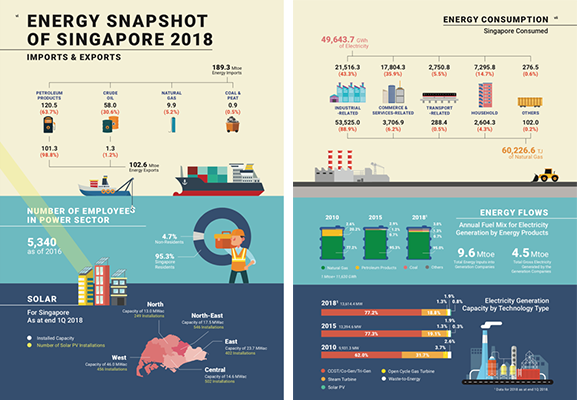The Energy Market Authority (EMA) of Singapore recently launched the Singapore Energy Statistics 2018. The annual publication provides a broad overview of Singapore’s energy landscape in 2018.

Notable highlights from the publication include:
1. Increased solar capacity in Singapore
Solar energy continues to be a beacon for sustainable energy in Singapore. The total electricity generation capacity in Singapore grew steadily from 13,445.1 MW in 2017 to 13,614.4 MW in 2018. This was due to the increased contribution of auto-producers, including solar photovoltaic (solar PV) systems.
The number of grid-connected solar PV installations has increased from 1,826 in 2016 to 2,155 in early 2018. As a result, the grid-connected installed capacity in Singapore has grown from 96.7 MWac in 2016 to 114.8 MWac in 1Q 2018.
Ongoing solar projects from public sector agencies are expected to drive further growth. The Housing & Development Board (HDB) and the Economic Development Board (EDB) are deploying more solar PV systems across Singapore through the SolarNova project, which was launched in 2014.
From 25.5 MWp in 2014, Singapore is now expected to reach the committed solar PV capacity of 350 MWp by 2020.
2. Natural gas dominates Singapore’s fuel mix
Natural gas now accounts for 95.2 per cent of Singapore’s fuel mix, thanks to new, highly-efficient Combined Cycle Gas Turbine (CCGT) plants that run on natural gas.
End-users’ consumption of natural gas increased by 5.8 per cent, from 56,949.2 TJ in 2016 to 60,226.6 TJ in 2017, due to stronger demand by the Industrial-related sector. Industrial-related consumption increased 7.1 per cent, from 49,968.5 TJ in 2016 to 53,525.0 TJ in 2017 and comprised 88.9 per cent of total natural gas consumption.
End-users’ consumption of natural gas increased by 5.8 per cent, from 56,949.2 TJ in 2016 to 60,226.6 TJ in 2017, due to stronger demand by the Industrial-related sector. Industrial-related consumption increased 7.1 per cent, from 49,968.5 TJ in 2016 to 53,525.0 TJ in 2017 and comprised 88.9 per cent of total natural gas consumption.
To accommodate the Republic’s increased demand for natural gas, imports of natural gas increased by 2.0 per cent (to 9.9 Mtoe in 2017), with Liquefied Natural Gas (LNG) accounting for 27.6 per cent of natural gas imports.
3. Electricity consumption continues to creep upwards
Singapore’s electricity consumption grew 2.1 per cent, from 48.6 TWh in 2016 to 49.6 TWh in 2017. The bulk of consumption came from Industrial-related sectors (43.3 per cent), Commerce & Services-related sectors (35.9 per cent), and Households (14.7 per cent).
Singapore’s electricity consumption grew 2.1 per cent, from 48.6 TWh in 2016 to 49.6 TWh in 2017. The bulk of consumption came from Industrial-related sectors (43.3 per cent), Commerce & Services-related sectors (35.9 per cent), and Households (14.7 per cent).